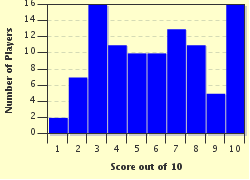Quiz Answer Key and Fun Facts
1. Enzymes are protein catalysts. Which of the following is the best definition of a catalyst?
2. Enzymes increase the rate of biochemical reactions by reducing the activation energy (the energy required to kick-start a reaction). The main way enzymes do this is by tightly binding the high energy species which is a midpoint between the substrate and the product. What name is given to this species?
3. Active sites of enzymes are the regions which directly interact with the substrate and oversee the biochemical reactions. Which of these is least important for an active site?
4. Enzymes are divided into six categories - oxidoreductases, transferases, hydrolases, lyases, isomerases, and ligases. Each class plays a distinctive role - for example, hydrolases catalyse the hydrolysis of chemical bonds. Which class of enzymes is most likely to be involved in the addition or removal of methane groups to/from proteins?
5. Most enzymes in the human body exist in an aqueous environment and the role of water is becoming seen as more and more important. Which of these is NOT an important contribution of water to catalysis?
6. Enzyme kinetics are described by what is known as the Michaelis-Menten equation, which relates the rate of reaction to the substrate concentration. For a fixed concentration of enzyme, the rate increases up to a point as substrate concentration increases. Beyond this point, however, the rate cannot increase. Why is this?
7. Specific enzymes require specific conditions in which to function, the slightest deviation from which can lead to a loss of functionality. Where in the body are you most likely to find enzymes which function best at acidic pH?
8. The Michaelis-Menten equation tells us that v = (Vmax x [S]) / (Km + [S]), where v is the rate of reaction, Vmax is the maximum rate of reaction, and [S] is the substrate concentration. Km is known as the Michaelis constant and is defined as the concentration of substrate needed to achieve half the maximum rate of reaction. What can we therefore say about Km?
9. It is very difficult to find values for Vmax and Km from experiments. Experimental data is often used to generate graphs which can be used to deduce these values. Which of the following is not one of the three linear graphical transformations of the Michaelis-Menten equation that can be used to deduce the Vmax and Km of an enzyme?
10. Carrying out such important roles in the body, enzymes must be tightly regulated. Which of these is NOT a type of inhibition that can be employed to control enzyme activity?
Source: Author
doublemm
This quiz was reviewed by FunTrivia editor
WesleyCrusher before going online.
Any errors found in FunTrivia content are routinely corrected through our feedback system.

